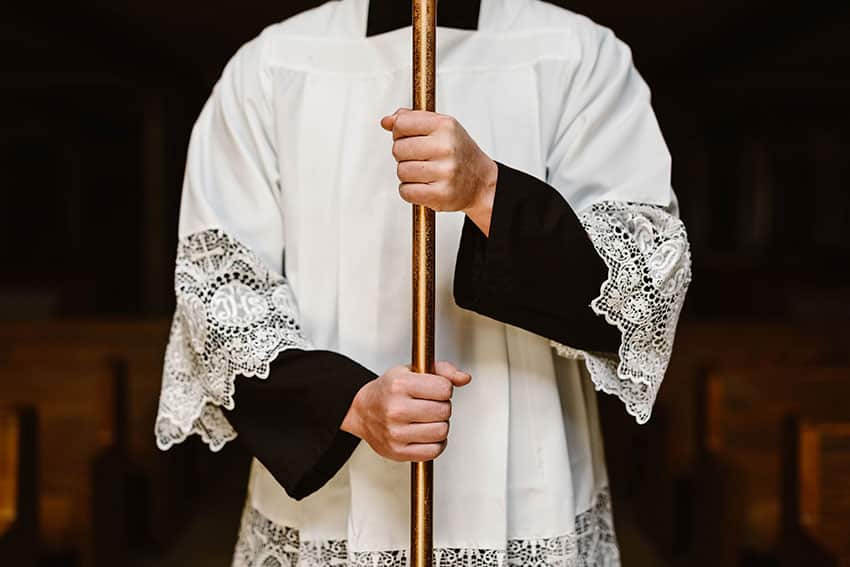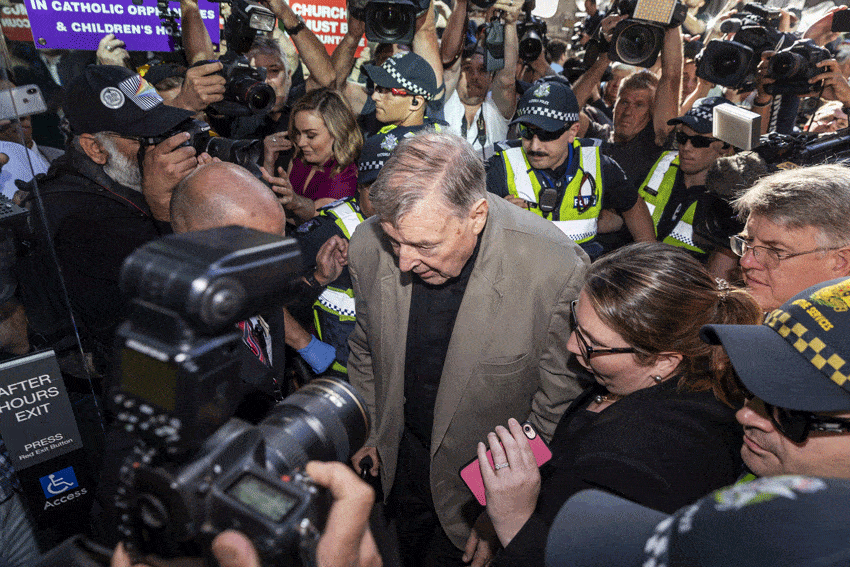
The main incident alleged in the Pell proceedings gave rise to four charges. I should say a word about the fifth charge which was truly preposterous. It relates to an incident alleged to have occurred two months after the first incident, in the crowded sacristy corridor as the choir and servers were processing together.
Like the thirteenth stroke of a clock, J’s account of this incident should have alarmed and alerted police, prosecutors and judges that not all was well with J’s recollection of events.
The allegation was that Pell having presided at a mass celebrated by Fr Brendan Egan had been at the rear of the procession at the end of mass, immediately behind Fr Egan. Pell had split from the procession and gone forward with many people congregated in the corridor, pinning J to the wall and sexually assaulting him.
The High Court’s damning judgement
Here is the High Court’s description:
“The assumption that a group of choristers, including adults, might have been so preoccupied with making their way to the robing room as to fail to notice the extraordinary sight of the Archbishop of Melbourne dressed ‘in his full regalia’ advancing through the procession and pinning a 13 year old boy to the wall, is a large one. The failure to make any formal report of such an incident, had it occurred, may be another matter.
“It is unnecessary to decide whether J’s description of the second incident so strains credulity as to necessitate that the jury, who saw and heard him give the evidence, ought to have entertained a reasonable doubt as to its occurrence. The capacity of the evidence to support the verdict on this charge suffers from the same deficiency as the evidence of the assaults involved in the first incident.”
If this charge were to be brought, you would think the police would want to lead evidence from Brendan Egan. You would think they would try and track down any others who would have been in the corridor that day.
Here is the shocking thing. To this day, the police have never even spoken to Egan.
Egan left the priesthood some years ago, but he was in gainful employment with a local council in Melbourne during the course of the legal proceedings and readily contactable.

No record …
And there is no ‘record of anyone undertaking any investigation about J’s allegations’ in relation to this incident.
Here is Richter’s cross-examination of Detective Sergeant Reed who was in charge of the ‘investigation’:
All right. We then go to Sunday 23 February?
– Yes.
Which is the only entry, of February, in the Connor diary, that has Archbishop Pell presiding. Right?
– Ah, for February, yes.
Right. Now, if you were investigating that occasion as a possibility?
– yes.
That Archbishop Pell is supposed to have pushed Mr J into the wall and grabbed his private parts, and squeezed them hard, you’d want to speak to Father Brendan Egan, wouldn’t you?
– Father Egan hasn’t been spoken to.
Why?
– Ah, I don’t have an answer for that. Because I haven’t spoken to him.
You see, because you’d want to know, from Father Egan, whether he went back in procession with Archbishop Pell, who had been presiding. You’d want to know that, wouldn’t you?
– Yes, that would be reasonable. Yes.
You’d want to know whether they disrobed together, in the sacristy?
– Yes. That would be reasonable.
Okay. So, no enquiries have been made in relation to February of 1997 at all that relate to this allegation? Of the second episode?
– No. Not in relation to Father Egan they haven’t, no.
No?
– No.
But in relation to anything that would provide any evidence about an alleged episode in February of ‘97?
– No investigations undertaken by me, no. The evidence that has been given is the only material.
Thank you. And when you say “not by me,” you were the leader of the team and interposed, contains all the activities of the team – – ?
– No, it doesn’t. I didn’t say that.
Well, is there any record of anyone undertaking any investigation about J’s allegations relating to February 1997?
– No. Not that I’m – not that I can categorically recall now. No.
Well, not that you recall at all?
– Not that I can recall, no.
Right. And if there had been, you’d have known about it?
– Yes, you would.
Yes. Thank you.

Demeanour wins
In the absence of any evidence from Egan or any person other than J who would have been present in that corridor, Chief Justice Ferguson and President Maxwell, impressed by J’s demeanour, accepted that this assault had been proved beyond reasonable doubt. Their Honours wrote:
Nor do we regard the description of the second incident as being so improbable as to entail a reasonable doubt. …[A] fleeting physical encounter of the kind described by J can be readily imagined. Jurors would know from common experience that confined spaces facilitate furtive sexual touching, even when others are in the same space. And the act of squeezing the genitals is, itself, unremarkable as a form of sexual assault. On J’s account, this was opportunistic offending, just as the first incident had been. On this occasion, however, it was over almost immediately. As he said in evidence-in-chief: ‘Just a quick, he squeezed and kept walking. It was something that was a complete and utter whirlwind. It was very quick.’
What does seem improbable to us — referring again to the defence’s ‘fabrication’ hypothesis — is that J would have thought to invent a second incident if his true purpose was to advance false allegations against Cardinal Pell.
Having to construct and maintain a story of a second and subsequent assault could only have made the undertaking much more difficult and risky for J, markedly increasing the likelihood that the whole story would unravel when tested.
A dissenting voice
Justice Weinberg in dissent observed:
Objectively speaking, this was always going to be a problematic case. The complainant’s allegations against the applicant were, to one degree or another, implausible. In the case of the second incident, even that is an understatement.
That is not so by reason of the complainant having alleged that he had been sexually abused, in the past, by a senior Catholic cleric. Sadly, as we have come to appreciate, there is nothing wholly improbable about allegations of that kind being true. It is, rather, by reason of the detailed circumstances that were said to have surrounded those allegations of abuse, circumstances as to time, place and manner.
Lord Atkin once wrote: “An ounce of intrinsic merit or demerit in the evidence, that is to say the value of the comparison of evidence with known facts, is worth pounds of demeanour.”
A farce of a case disintegrates
Having assessed the intrinsic merit of the scant evidence available on the fifth charge, Justice Weinberg and all seven Justices of the High Court had no hesitation in acquitting Pell of this charge.
If the DPP were to proceed with this charge, and if the police were to propose this allegation for prosecution, they should at least have ensured that Egan was spoken to, if not called as a witness.
It’s a farce that the policeman in charge of the investigation had to answer under oath that there was absolutely no ‘record of anyone undertaking any investigation about J’s allegations relating to February 1997’.
Related
